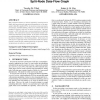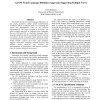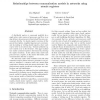367 search results - page 49 / 74 » Agent-Oriented Modeling with Graph Transformation |
FMOODS
2006
13 years 10 months ago
2006
Meta modeling is a wide-spread technique to define visual languages, with the UML being the most prominent one. Despite several advantages of meta modeling such as ease of use, the...
CORR
2007
Springer
13 years 9 months ago
2007
Springer
We propose a new graph representation for ISI channels that can be used for combined equalization and decoding by linear programming (LP) or iterative message-passing (IMP) decodi...
GLVLSI
2002
IEEE
14 years 2 months ago
2002
IEEE
Many computation-intensive or recursive applications commonly found in digital signal processing and image processing applications can be represented by data-flow graphs (DFGs). ...
VL
2000
IEEE
14 years 1 months ago
2000
IEEE
The formal approach to visual language definition is to use graph grammars and/or graph transformation techniques. These techniques focus on specifying the syntax and manipulation...
IPPS
2006
IEEE
14 years 3 months ago
2006
IEEE
A distributed system is commonly modelled by a graph where nodes represent processors and there is an edge between two processors if and only if they can communicate directly. In ...



